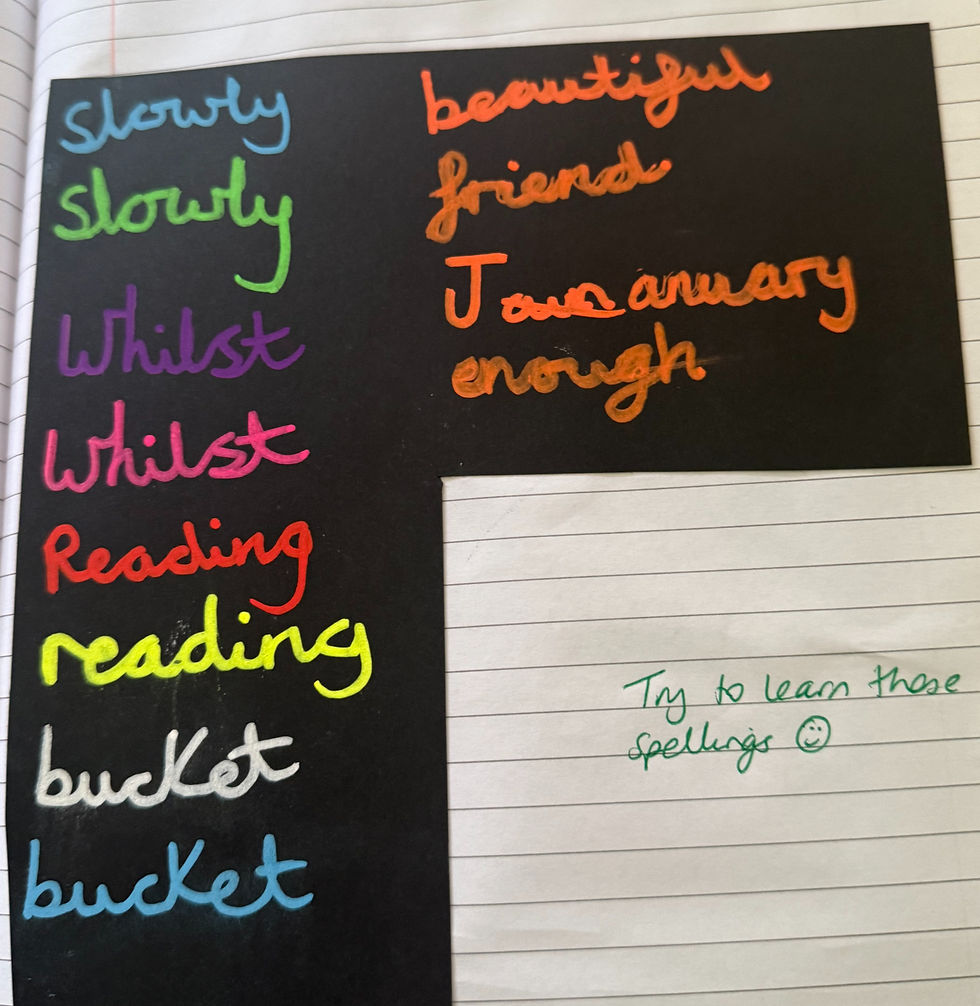Effective Spelling Techniques for Dyslexia Support
- Nicola Collings

- 5 days ago
- 4 min read
Helping a child with dyslexia improve their spelling can feel like a big challenge. But with the right approach, it becomes a journey full of small victories and growing confidence. I want to share some effective spelling strategies for dyslexia that have helped many children thrive. These techniques are practical, easy to apply, and designed to make learning enjoyable and rewarding.
Spelling is more than memorising words. It’s about understanding patterns, sounds, and meanings. When we break down spelling into manageable steps, children can build skills at their own pace. Let’s explore how to make spelling a positive experience.
Spelling Strategies for Dyslexia: A Gentle Approach
When supporting a child with dyslexia, patience and encouragement are key. Spelling strategies for dyslexia focus on multisensory learning. This means engaging more than one sense at a time - seeing, hearing, touching, and even moving. This approach helps the brain connect letters and sounds more effectively.
Here are some strategies I find especially helpful:
Use phonics-based methods: Break words into sounds and blend them together. For example, the word "cat" can be split into /c/ /a/ /t/. Saying the sounds aloud while writing helps reinforce the connection.
Incorporate visual aids: Colour-code parts of words or use flashcards with pictures. Visual clues make words easier to remember.
Practice with tactile materials: Writing letters in sand, using playdough to form words, or tracing letters with fingers in the air and saying the names of the letters can improve muscle memory.
Encourage repetition in short bursts: Frequent, brief practice sessions work better than long, tiring ones.
Celebrate every success: Positive reinforcement builds motivation and self-esteem.
These strategies create a supportive environment where children feel safe to try, make mistakes, and improve.

What are the four strategies for spelling?
Understanding the four main strategies for spelling can guide your support effectively. These strategies help children approach spelling from different angles, making learning more comprehensive.
Phonological Strategy
This involves sounding out words. Children learn to identify individual sounds (phonemes) and match them to letters or groups of letters. It’s the foundation of spelling for many learners.
Visual Strategy
This strategy relies on recognising the shape and pattern of words. Children memorise how words look, which is especially useful for irregular words that don’t follow typical phonetic rules.
Morphemic Strategy
Here, children learn about the smallest units of meaning in words, such as prefixes, suffixes, and root words. Understanding these parts helps with spelling longer or more complex words.
Etymological Strategy
This involves learning the origin of words. Knowing where a word comes from can explain unusual spellings and help children remember them better.
By combining these strategies, children can tackle spelling challenges from multiple perspectives. This holistic approach is particularly effective for dyslexia support.

Practical Tips to Boost Spelling Confidence
Building spelling skills is a step-by-step process. Here are some practical tips that you can use right away to support a child’s learning journey:
Create a spelling-friendly space: A quiet, well-lit area with all necessary materials close by helps children focus.
Use technology wisely: Apps and games designed for spelling can make practice fun and interactive.
Keep a personalised word list: Include words the child struggles with and review them regularly.
Encourage writing for real purposes: Journals, letters, or stories motivate children to use spelling in meaningful ways.
Break words into chunks: Teach children to divide longer words into syllables or smaller parts.
Read together daily: Reading aloud exposes children to correct spelling and builds vocabulary.
Remember, every child learns differently. Adjust these tips to fit their unique needs and celebrate progress, no matter how small.

How to Use Spelling Learning Techniques Effectively
Integrating spelling learning techniques into daily routines can make a big difference. Consistency is important, but so is keeping the experience positive and stress-free.
Here’s how to make the most of these techniques:
Set achievable goals: Start with simple words and gradually increase difficulty.
Mix up activities: Use a variety of methods like writing, speaking, and listening to keep engagement high.
Use multisensory tools: Letter tiles, sand trays, and apps that speak words aloud help reinforce learning.
Provide immediate feedback: Gently correct mistakes and explain why, so children understand and learn.
Encourage self-correction: Teach children to check their own work, fostering independence.
Involve the whole family: Practice spelling during everyday activities like shopping lists or cooking.
By weaving these techniques into everyday life, spelling becomes a natural and enjoyable part of learning.

Supporting Spelling Growth Over Time
Spelling improvement is a journey, not a race. It’s important to track progress and adjust strategies as needed. Here are some ways to support ongoing growth:
Keep a progress journal: Note improvements and areas needing more work.
Celebrate milestones: Recognise achievements with praise or small rewards.
Stay patient and positive: Encourage effort rather than perfection.
Seek professional support if needed: Tutors specialising in dyslexia can provide tailored guidance.
Encourage reading and writing outside of lessons: The more children engage with words, the stronger their skills become.
Remember, every step forward builds confidence and independence. With the right support, children can overcome spelling challenges and enjoy learning.
Spelling can be tricky, but with warmth, patience, and the right strategies, it becomes a path to success. Keep encouraging, keep practising, and watch your child’s confidence soar!
_edited.png)



Comments